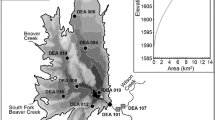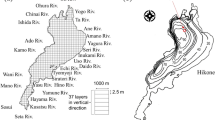Abstract
A case study was conducted on the potential impacts of climate change on fish habitat in a southeastern reservoir. A reservoir water quality model and one year of baseline meteorologic, hydrologic, and inflow water quality input were used to simulate current reservoir water quality. Total adult striped bass habitat, defined by specific quantitative temperature and dissolved oxygen criteria, was simulated. Daily reservoir volumes with optimal, suboptimal, and unsuitable temperature and DO were predicted for the year. Output from recent runs of atmospheric general circulation models (GCMs), in which atmospheric carbon dioxide concentrations have been doubled, was then used to adjust the baseline inputs to the water quality model. New sets of input data were created for two grid cells for each of three GCMs. All six climate scenarios are predicted to cause overall declines in the available summer striped bass habitat, mostly due to lake water temperatures exceeding striped bass tolerance levels. These predictions are believed to result from the consensus among GCM scenarios that air temperatures and humidity will rise, and the sensitivity of the reservoir model to these parameters. The reservoir model was found to be a promising tool for examining potential climate-change impacts. Some of the assumptions required to apply GCM output to the reservoir model, however, illustrate the problems in using large-scale gridcell output to assess small-scale impacts.
Similar content being viewed by others
References
Bender, M. D., Hauser, G. E., Shiao, M. C., and Proctor, W. D.: 1990, ‘BETTER: A Two-Dimensional Reservoir Water Quality Model, Technical Reference Manual and User's Guide’, TVA Report no. WR28–2–590–152, Tennessee Valley Authority Engineering Lab, Norris, Tennessee.
Brown, R. T.: 1985, ‘Flow and Mixing Calculations for a Two-Dimensional Reservoir Water Quality Model’, in W. R. Waldrop (ed.), Hydraulics and Hydrology in the Small Computer Age: Proceedings of the ASCE Hydraulics Specialty Conference, August 1985, American Society of Civil Engineers, New York, pp. 686–693.
Brown, R. T. and Nubbe, C. E: 1987, ‘Modeled Effects of Hydraulic Mixing Devices on Reservoir Water Quality’, in R. M. Ragan (ed.), Hydraulics Engineering: Proceedings of the 1987 National Conference on Hydraulic Engineering, August 1987, American Society of Civil Engineers, New York, pp. 48–55.
Brown, R. T., Nubbe, C. F., and Husin, B.: 1987, ‘Douglas Reservoir Water Quality Modeling to Evaluate Mixing Devices’, TVA Report no. WR28–2–20–106, Tennessee Valley Authority Engineering Lab, Norris, Tennessee.
Coutant, C. C., 1985, ‘Striped Bass, Temperature, and Dissolved Oxygen: A Speculative Hypothesis for Environmental Risk’, Transactions of the American Fisheries Society 114, 31–61.
Coutant, C. C.: 1986, ‘Thermal Niches of Striped Bass’, Scientific American 254, 98–104.
Cushman, R. M. and Spring, P. N.: 1989, ‘Differences among Model Simulations of Climate Change on the Scale of Resource Regions’, Environmental Management 13, 789–795.
Gates, W. L.: 1985, ‘The Use of General Circulation Models in the Analysis of the Ecosystem Impacts of Climate Change’, Climatic Change 7, 267–284.
Grotch, S. L.: 1988, ‘Regional Intercomparisons of General Circulation Model Predictions and Historical Climate Data’, U.S. Department of Energy, DOE/NBB-0084, Washington, D.C.
Jenne, R. L.: 1987a, ‘Data for EPA Studies’, NCAR/EPA Project Document 3, National Center for Atmospheric Research, November 23, 1987.
Jenne, R. L.: 1987b, ‘Print of U.S. Data from the GISS Model’, NCAR/EPA Project Document 2, National Center for Atmospheric Research, revised October 27, 1987.
Jenne, R. L.: 1988, ‘Data from the OSU 1 ×, 2 × CO2 Model’, NCAR/EPA Project Document 5, National Center for Atmospheric Research, February 19, 1988.
Jenne, R. L.: 1989, ‘Data from Climate Models; the CO2 Warming’, National Center for Atmospheric Research, Draft.
Kellogg, W. W. and Zhao, Z-C.: 1988, ‘Sensitivity of Soil Moisture to Doubling of Carbon Dioxide in Climate Model Experiments. Part I: North America’, Journal of Climate 1, 348–366.
Lettenmaier, D. P. and Gan, T. Y: 1990, ‘Hydrologic Sensitivities of the Sacramento-San Joaquin River Basin, California, to Global Warming’, Water Resources Research 26, 69–86.
Miller, B. A., Brock, W. G., and Waldrop, W. R.: 1988, ‘Potential Effects of Global Climatic Change on the Tennessee Valley Authority Reservoir System’, presented at the 1988 National Conference on Hydraulic Engineering, Colorado Springs, Colorado, August 8–12.
Schlesinger, M. E. and Mitchell, J. F. B.: 1987, ‘Climate Model Simulations of the Equilibrium Climatic Response to Increased Carbon Dioxide’, Reviews of Geophysics 25, 760–798.
Setzler, E. M., Boynton, W. R., Wood, K. V, Zion, H. H., Lubbers, L., Mountford, N. K., Frere, P., Tucker, L., and Mihursky, J. A.: 1980, ‘Synopsis of Biological Data on Striped Bass, Morone saxatilis (Walbaum)’, NOAA Technical Report NMFS Circular 433/FAO Synopsis no. 121.
U.S. Environmental Protection Agency: 1986, ‘Ambient Water Quality Criteria for Dissolved Oxygen’, EPA 44-/5-86-003, Washington, D.C.
Author information
Authors and Affiliations
Rights and permissions
About this article
Cite this article
Chang, L.H., Railsback, S.F. & Brown, R.T. Use of a reservoir water quality model to simulate global climate change effects on fish habitat. Climatic Change 20, 277–296 (1992). https://doi.org/10.1007/BF00142423
Received:
Revised:
Issue Date:
DOI: https://doi.org/10.1007/BF00142423




